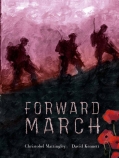 Left! Left! Left! Right! Left!
Left! Left! Left! Right! Left!
We make our way in the dark.
Early in the morning – before dawn – a family makes its way to a memorial service, standing together to remember the fallen. With the other people who gather they remember, through words, through silence, and through the last post, men and women who have died in combat.
Reflection , a picture book, was released in time for this year’s ANZAC Day, equally serves to explore other such ceremonies, including Remembrance Day. The text , just a sentence per spread, observes simply what happens at such a ceremony. However, the illustrations add an extra dimension – with one page in each spread showing what is happening in the contemporary ceremony, and the other page showing scenes of war. So, for example, in the first spread, as the modern family males their way through the dark, so do the soldiers of old. The modern illustrations use gentle colours, while the scenes of war use khakis and sepia tones. Background washes of grey skies span both scenes, linking them. In the final spread there are a mix of coloured and grey figures walking together, suggesting that the departed are marching with the living. Back of books notes highlight the conflicts Australian and New Zealand forces have served in, from the Boer War to Afghanistan in the present.
A beautiful, haunting book suitable both for classroom use and private reading.
Reflection: Remembering Those Who Serve in War, by Rebecka Sharpe Shelberg & Robin Cowcher
Walker Books, 2016
ISBN 9781922179050
Teacher’s notes are available here.

 In towns and cities across Australia bells ring,
In towns and cities across Australia bells ring, Left! Left! Right! Left!
Left! Left! Right! Left!
